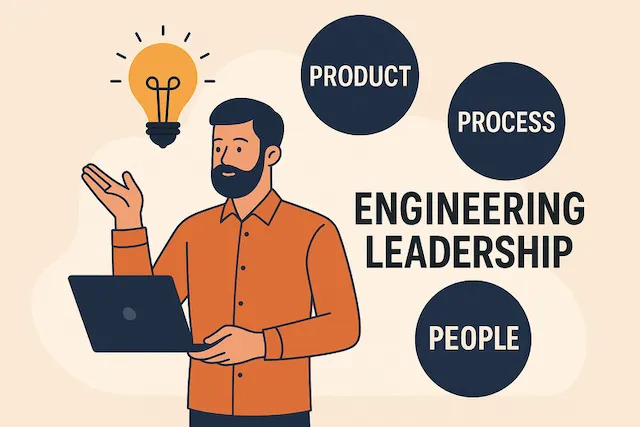02. What Is Engineering Leadership?

Engineering leadership is a role that blends technical insight with strategic direction, people management, and operational excellence. Unlike purely technical roles or traditional management, engineering leaders must wear many hats. They are responsible for building great products, enabling efficient processes, and growing empowered teams.
To put it simply: engineering leadership is the art and science of aligning Product, Process, and People — the “3Ps” — to drive impact in a sustainable, scalable, and human-centered way.
Let’s break down what each of these Ps means in practice, and how engineering leaders operate within them.
1. Product: Driving Value Through Technology
The first “P” stands for Product. Engineering leaders must deeply understand the product their team is building — not just how it works technically, but why it exists and what problems it solves.
Responsibilities in the Product Domain:
- Understanding the business goals. An engineering leader connects the technical work to the company’s strategic priorities. They translate business outcomes into engineering outcomes.
- Collaborating with Product Managers. They form a tight partnership with product counterparts, contributing technical feasibility insights, effort estimation, and risk assessment.
- Shaping the roadmap. Engineering leaders ensure that the engineering team is working on the right things — not just building faster, but building the right features, in the right way.
- Balancing quality and speed. They advocate for long-term code health, technical debt management, and platform scalability while delivering customer value.
A great engineering leader doesn’t just say “yes” or “no” to features — they help shape what is built and how it delivers value.
2. Process: Enabling Sustainable Execution
The second “P” is Process. Behind every successful engineering team is a well-oiled system that enables people to build, test, and ship software efficiently.
Responsibilities in the Process Domain:
- Designing and evolving team workflows. Whether it’s Scrum, Kanban, or something custom, engineering leaders adapt methodologies to fit the team’s context — not the other way around.
- Creating feedback loops. They ensure the team has mechanisms to continuously learn and improve, such as retrospectives, incident reviews, and code quality metrics.
- Optimizing delivery pipelines. A strong leader helps reduce friction in the release process — through CI/CD, automation, documentation, and tooling.
- Managing risk and scalability. They enforce architectural governance, guardrails, and standards that allow teams to move fast without breaking things.
Process isn’t just bureaucracy. Done right, it’s an enabler of autonomy and a protector of quality.
3. People: Building and Empowering Teams
The third and most critical “P” is People. Engineering leaders are, above all, people leaders. They are responsible for hiring, developing, and retaining top engineering talent — and creating an environment where that talent thrives.
Responsibilities in the People Domain:
- Coaching and mentoring. Engineering leaders provide career guidance, regular feedback, and growth opportunities to engineers at all levels.
- Hiring and team formation. They are involved in recruiting, interviewing, onboarding, and building diverse and balanced teams.
- Creating a healthy culture. Leaders foster psychological safety, accountability, and trust. They set the tone for communication, collaboration, and inclusion.
- Resolving conflict. Whether it’s interpersonal tension, misalignment with other functions, or tough decisions about roles — they step in with empathy and clarity.
Technical decisions matter. Processes matter. But nothing has more lasting impact than how you treat your people. As the saying goes: culture eats strategy for breakfast.
Why the 3Ps Must Be Balanced
Many new engineering managers make the mistake of focusing on only one of the 3Ps. They might spend too much time coding and ignore team dynamics. Or get buried in process while losing sight of product goals. Or only focus on people, without aligning the team to business value.
True engineering leadership lies in balancing all three:
- A product with no process becomes chaotic.
- A process with no people-focus becomes mechanical.
- A team with no product direction becomes disconnected.
Engineering leaders create impact not by excelling in just one P, but by harmonizing all three to move the organization forward.
Final Thoughts
Engineering leadership isn’t just a job title — it’s a mindset. It’s about taking responsibility for outcomes, not just outputs. It’s about creating clarity in uncertainty. It’s about enabling others to do their best work.
Whether you’re a tech lead aspiring to management, a new EM figuring things out, or a senior leader scaling teams — remember the 3Ps: Product, Process, People.
They are your compass. Use them well.